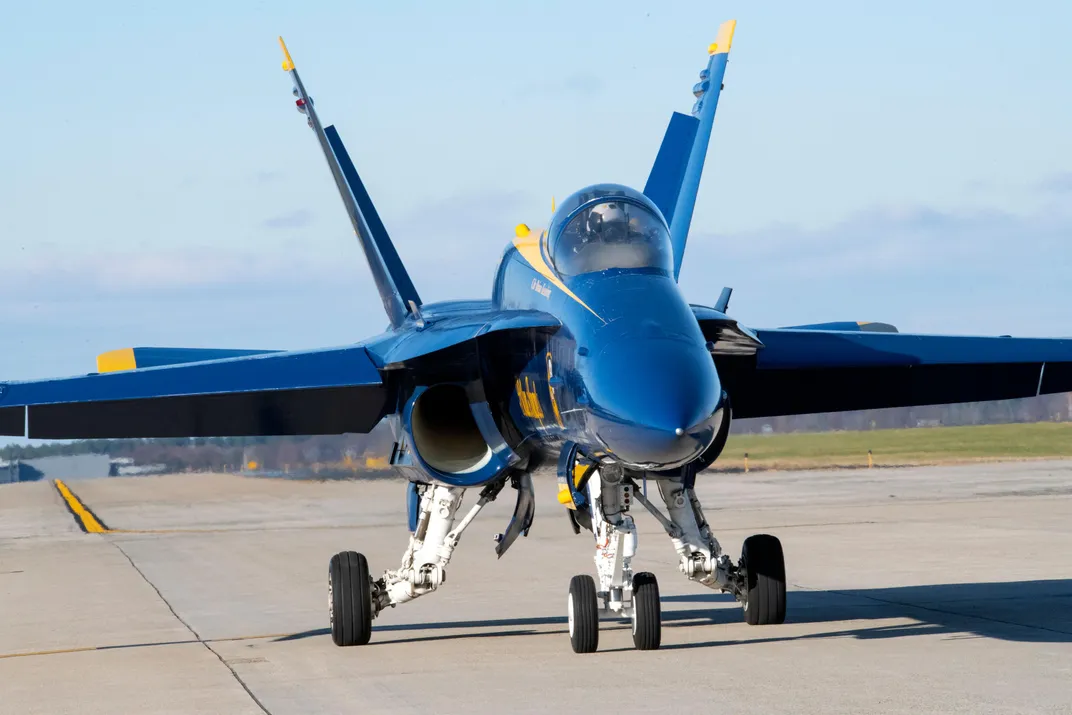A Special Air Delivery From the U.S. Navy Arrives With Only a Few Dings
An F/A-18C Blue Angels Hornet just flew into D.C. to make its debut as a museum artifact at the National Air and Space Museum
:focal(1055x715:1056x716)/https://tf-cmsv2-smithsonianmag-media.s3.amazonaws.com/filer/d7/cd/d7cda4f2-2bb6-4a40-9f33-7528afe5c759/50618995767_da0453e8bb_o.jpg)
You could hear it before you saw it. The distant roar of the powerful twin jet engines grew steadily louder as the streaking navy blue jet with yellow trim approached. Then it was on you before you knew it. The sleek aircraft soared by in a blur, turned and came in for a perfect landing yesterday at Dulles International Airport.
The Smithsonian National Air and Space Museum’s newest aircraft artifact had just arrived. The F/A-18C Hornet with the familiar Blue Angels markings then taxied over to the museum’s nearby Udvar-Hazy Center and came to a gentle stop in front of the restoration hangar.
“We’re very happy to have this aircraft in our collection,” says Laurence Burke, curator of U.S. naval aviation for the museum. “We look forward to getting it out on the floor where people can see it. The F/A-18 was a game-changer. This was the first operational U.S. Navy fighter jet designed with integrated circuits and an all-glass cockpit with multifunction displays.”
Introduced by McDonnell Douglas in 1979, the F/A-18 fundamentally changed the air wing of America’s carrier fleet, which began using the plane in 1984. Its versatility as an air-to-air and air-to-ground jet fighter enabled the Navy to simplify its deployment strategy by focusing on a single aircraft.

“From 2006 to today, the Navy carriers have been almost entirely Hornets,” Burke says. “This is probably the closest the Navy has come to having just one airframe on a carrier. It simplifies maintenance, it simplifies part storage, it simplifies mission planning. If one airplane can do air-to-air and air-to-ground, it makes it a lot easier.”
Delivered to the Navy in 1987, this specific Hornet was one of the first C models built. It flew with eight different squadrons, including Strike Fighter Squadron (VFA) 86 during Operation Desert Storm—the first Gulf War—in 1991 and with VFA-83 to enforce the no-fly zone over southern Iraq in 1994.
Since 2015, the jet has served with the Blue Angels, the precision flight demonstration squadron of the U.S. Navy. After combat operations, the F/A-18C was specially modified to meet the exacting demands of this elite aerobatic team, known for its gravity-defying feats and hair-raising performances.

“Navy aircraft need more than just a paint job to become a Blue Angels airplane,” Burke says. “It must undergo numerous changes to make it suited to fly with the Blues. The stick and throttle controls are modified to make it easier for aviators to make the fine adjustments necessary to keep in tight formations, the fuel system is changed to permit longer periods of inverted flight, and a smoke system has to be added.”
The F/A-18 C and D Hornets were retired by the Blue Angels after the 2020 season. The squadron will now fly the Super Hornet, the F/A-18 E and F models, which are about 30 percent larger than the earlier versions.
Burke hopes to have the National Air and Space Museum’s—Navy Bureau Number 163439—on display soon at the Udvar-Hazy Center in Chantilly, Virginia, however the Smithsonian Institution announced today Udvar-Hazy will close Monday due to increased Covid-19 cases nationally and around the region.
The aircraft will join other naval aviation greats, such as the F6F-3K Hellcat, F-4S Phantom II, A-6E Intruder and F-14D Tomcat—perhaps as early as December.
However, before that can happen, the Blue Angels jet needs to undergo a bit of rehabilitation. First, all the fluids—including the JP5 jet fuel—need to be drained. They tend to be corrosive and can cause deterioration to the aircraft over time. Then it needs to be made visitor-friendly.
“We have to take off the things that go bang,” Burke says. “There are a couple of rocket motors in the ejection seat and then there’s the canopy jettison system. There are a few other cartridge-activated devices that need to be removed. They’re not exploding per se, but they are designed to release gas quickly to make something happen. We want to get them out so they don’t go off when somebody bumps into them.”
Other than that, the F/A-18C Hornet is ready to be exhibited. It is in near-perfect condition even after being put through a myriad of maneuvers with the Blue Angels: rolls, dives, loops, tight formations and synchronized passes, which did cause some wear and tear to the plane’s surface.
“We have no plans to repaint it,” Burke says. “From a distance, it looks fantastic. Up close, you can see flying the airplane has worn off paint in places. We have no intention of fixing that because we want to show it as it was used.”
He adds, “This new addition to our collection will not only let us tell stories about its time in combat, but also say more about the Navy’s flight demonstration team.”
/https://tf-cmsv2-smithsonianmag-media.s3.amazonaws.com/accounts/headshot/dave.png)
/https://tf-cmsv2-smithsonianmag-media.s3.amazonaws.com/accounts/headshot/dave.png)